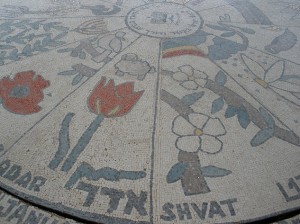 This week, I cannot refer to “this week’s reading” and be universally accurate. The Torah portion read this week in Israel is “out of sync” with the rest of the world, a phenomenon that will continue for another month. This is because while Israel celebrates the holy days of the three festivals on one day each, those living outside Israel celebrate them for two. Since the last day of Passover was on Friday this year, in Israel they read Parshas Shemini on Shabbos, while outside Israel, we read the special reading for the eighth day of Passover, and will read Shemini this week.
This week, I cannot refer to “this week’s reading” and be universally accurate. The Torah portion read this week in Israel is “out of sync” with the rest of the world, a phenomenon that will continue for another month. This is because while Israel celebrates the holy days of the three festivals on one day each, those living outside Israel celebrate them for two. Since the last day of Passover was on Friday this year, in Israel they read Parshas Shemini on Shabbos, while outside Israel, we read the special reading for the eighth day of Passover, and will read Shemini this week.
This causes a minor inconvenience for many people. Many apps and webpages written in Israel, for instance, refer to a different Torah reading than those written outside it. This week, many who are about to travel to Israel will walk to places where they can listen to Israel’s reading in order to “catch up.”
Now of course, you can find some people today who say that we really should only have one Passover Seder. This usually comes from the same sources that claim that Ashkenazic Jews shouldn’t care about eating kitniyos (legumes, rice, etc.) on Passover anymore — and that oh, by the way, the traditionalists are so monolithic! As I have written before, we should celebrate the diversity of customs that have developed over thousands of years of Jewish history, all surrounding a common core of Torah and Rabbinic legislation designed to encourage us to come closer to G-d.
For the record, I recently saw a webpage which explained accurately that the reason why Jews outside Israel observed two days of the holidays was because the community in Babylon could not receive timely word from Jerusalem concerning which of two possible days was consecrated as the new month, because this was done only based upon eyewitness testimony before the Sanhedrin, the supreme religious court. The same page, however, also asserts that this practice “continued even after mathematical models made it possible to calculate the date of the new moon.”
This latter statement is inaccurate: the mathematical models were in Jewish hands from the time that the Torah was given, to a degree of accuracy that required NASA to replicate. That is why we can still rely upon the calendar established by Hillel Sheni (the second Rabbi Hillel), although it is nearing two millenia since his lifetime. He created a set calendar not because he had developed a mathematical model, but because he recognized that there would soon not be a Sanhedrin to receive witnesses! The festivals still carry with them the message that the Jewish people has the ability to affect the entire world, spiritually, by affecting the time when the spiritual powers encapsulated within the festivals come into the world once again.
One day soon, we should hope to see the day when everyone returns to Israel, observes one day of all holidays, and a cloudy evening might affect when they are!




Dear Rabbi Menken,
Please provide the evidence for your assertion that “the mathematical models were in Jewish hands from the time that the Torah was given”
Dear Rabbi
As I am studying sciences history I am very much interrested in having more details about the technical way of predicting moon appearance on Sanhedrin time. Could you telle me were I can get more information about this specific aspect? Thanks in advance.
A cordial shalom
It’s part of the Oral Law — Rabban Gamliel states that he received from the House of Hillel (his grandfather) that the time between new moons is “29 days, and 1/2 a day, and 2/3 of an hour, and 73 “chalakim” (a “chelek” being 1/1080 hours). This totals 29.53059 days. [See Rosh HaShanah 25a] This calculation was originally used to prove that witnesses who thought they saw the moon earlier were mistaken — in the example there, people mistook a cloud as the new moon’s crescent on a cloudy evening.
The following is from Wikipedia: “A synodic month is 29.53059 days (29 days, 12 hours, 44 minutes, 2.8 seconds) and is measured from New Moon to New Moon.”
Maimonides says that our calculation is done by comparing the time that the first year began with the start of the “prior” year, referring to the year which ended on the sixth day of Creation. The first new moon coincided with the Creation of Adam, 2 hours after daybreak (14 hours from sunset, the start of a Jewish day) into the sixth day. The prior year’s first new moon began 5 and 204/1080 hours into the second day.
Rabbeinu Bechayah says that you can find the time of the pre-creation New Year’s encoded in the Torah.
In actuality, this is an approximation: “Because of perturbations in the orbits of the Earth and Moon, the actual time between lunations may range from about 29.18 to about 29.93 days. The long-term average duration is 29.530589 days (29 d 12 h 44 min 2.9 s).” The calculation provided by Rabban Gamliel is the closest approximation that could be provided in “chalakim,” and is accurate to one day in 14,000 years.
At roughly the same time that Rabban Gamliel was saying this (in the middle of the 1st Century CE), the church was adopting the Julian calendar, in which the vernal equinox was to occur on March 25. By the year 1582, the equinox had moved back to March 11. Pope Gregory XIII dropped October 5 – 14 from the calendar that year such that March 21 became the equinox (it was March 21 in 325, the year the Council of Nicaea met), redid the calculation of leap years, and put us on the current and more accurate schedule — which has an error of about one day per 3,300 years.
Would not every month start with the new moon.?
I am borne in Indonesia, Java.
The Indonesia farmer looks at the heaven to find the time to sow.
They give the land also a year rest after six years. At least they did this when I was young, I don’t now if they still do this, or that the westerners have changed it.
Just before I arrived here in Israel the 4th of April this year. It seemed to me that the Hebrew calendar was not in line with the moon faces. One day off. Am I wrong?
Although I understand that the above would apply to Rosh Hashana, the fact that everyone only keeps one day Yom Kippur should mean that the first day of Succot could always be predicted. Also, since Pesach is 14 days in to the month, this would have given enough time for the messengers to reach Babylon from Israel and of course Shavuot does not have a date and is calculated from Pesach. As everyone, including those in Israel keep 2 days for Rosh Hashana, everything else could therefore be one day.
Shalom